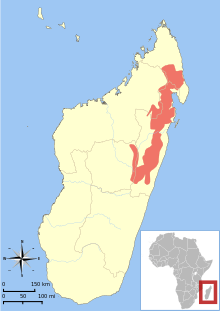Eastern woolly lemur
| Eastern woolly lemur | |
|---|---|
 | |
| Scientific classification | |
| Kingdom: | Animalia |
| Phylum: | Chordata |
| Clade: | Synapsida |
| Class: | Mammalia |
| Order: | Primates |
| Suborder: | Strepsirrhini |
| Family: | Indriidae |
| Genus: | Avahi |
| Species: | A. laniger |
| Binomial name | |
| Avahi laniger Gmelin, 1788[3] | |
 | |
| Distribution of A. laniger[1] | |
| Synonyms | |
| |
The eastern woolly lemur (Avahi laniger), also known as the eastern avahi or Gmelin's woolly lemur, is a species of woolly lemur native to eastern Madagascar, where it lives in the wet tropical rainforest at low elevations along the eastern coast of the island or they can also inhabit the northern tip of the island with other species.[4] The woolly lemur name refers to their thick, tightly-curled hair, whereas their generic name avahi refers to their high-pitched defensive call. The eastern woolly lemur almost has an owl-look with its large eyes, small rounded head, and ears that are mostly hidden.[5] This nocturnal animal weighs 1.0–1.3 kg and reaches a length of 27–29 cm with a tail of 33–37 cm. Its diet consists mainly of leaves and buds with fruits, flowers, and bark.
Eastern woolly lemurs live in monogamous pairs together with their offspring. The eastern woolly lemur's breeding season ranges from March to May with the baby lemurs being born around August to September.[6]
Other lemur species that live in the same rainforests as eastern woolly lemur are the diademed sifaka (Propithecus diadema) and the red-bellied lemur (Eulemur rubriventer). In southeastern rainforests, sympatric lemur species of A. meridionalis are the brown mouse lemur (Microcebus rufus), the greater dwarf lemur (Cheirogaleus major), the fat-tailed dwarf lemur (Cheirogaleus medius) and the collared brown lemur (Eulemur collaris) in Sainte Luce Forest, and the southern lesser bamboo lemur (Hapalemur meridionalis) in Mandena Forest.

References
| Wikispecies has information related to: Eastern woolly lemur |
- 1 2 Andriaholinirina, N.; et al. (2014). "Avahi laniger". IUCN Red List of Threatened Species. Version 2014.1. International Union for Conservation of Nature. Retrieved 2014-06-15.
- ↑ "Checklist of CITES Species". CITES. UNEP-WCMC. Retrieved 18 March 2015.
- ↑ Groves, C.P. (2005). Wilson, D.E.; Reeder, D.M., eds. Mammal Species of the World: A Taxonomic and Geographic Reference (3rd ed.). Baltimore: Johns Hopkins University Press. p. 119. ISBN 0-801-88221-4. OCLC 62265494.
- ↑ Andriantompohavana, R., et al. "Characterization of 22 Microsatellite Loci Developed from the Genome of the Woolly Lemur ( Avahi Laniger)." Molecular Ecology Notes, vol. 4, no. 3, Sept. 2004, pp. 400-403. EBSCOhost, doi:10.1111/j.1471-8286.2004.00665.x.
- ↑ "Eastern Woolly Lemur Photos and Facts." Arkive. Wildscreen Arkive, n.d. Web. 02 May 2017. <http://www.arkive.org/eastern-woolly-lemur/avahi-laniger/>.
- ↑ Ehler, Pam. "Avahi Laniger (avahi)." Animal Diversity Web. N.p., 2002. Web. 02 May 2017. <http://animaldiversity.org/accounts/Avahi_laniger/>.
